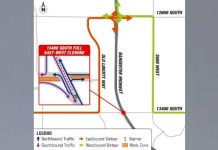LITTLE COTTONWOOD CANYON, Utah, June 29, 2021 (Gephardt Daily) — Officials have released video of what a proposed gondola route in Little Cottonwood Canyon would look like.
“Want to know what having a gondola in Little Cottonwood Canyon will be like?” said a news release from Gondola Works, a coalition of stakeholders, canyon users and businesses who are working to solve the long-term transportation problems of Little Cottonwood Canyon.
“A new video lets you experience the actual system proposed. Beginning at the base station at La Caille, the video shows the journey from the hub where gondola riders start to the top of the canyon.”
State Route 210, which is the only road in and out of Little Cottonwood Canyon, is the most avalanche prone highway in North America and has more than a million visitors year-round, the news release said. Gondolas provide secondary emergency access when that road is blocked by avalanche debris or stuck buses and cars.
“A gondola is the sustainable solution if you want to protect Utah’s natural resources and air quality,” the news release said. “Over the 50-year life of a gondola, it will produce 300% less CO2 than buses and eliminate as many as 1,400 vehicles an hour headed up the canyon.”
UDOT is currently in its last public comment period of an Environmental Impact Statement to determine the best transportation system that improves the reliability, mobility, and safety for residents, visitors, and commuters who use SR-210. The gondola is one of two preferred alternatives being considered. The other alternative includes widening the road the length of the canyon from two lanes to four and adding concrete snowsheds to allow for more bus service.
“A gondola system is estimated between $500 million and $550 million, which is about the same as widening the road and adding buses,” the news release said. “UDOT is proposing an additional $80 million for snowsheds — which are a surface transportation cost and not needed for the gondola alternative. The annual cost to operate and maintain the gondola is a little over $10 million, which is less than the annual cost for buses — and the gondola system lasts three times longer.”





